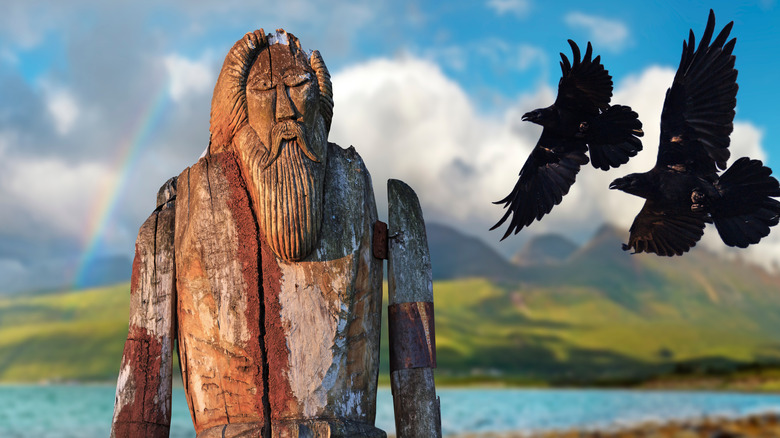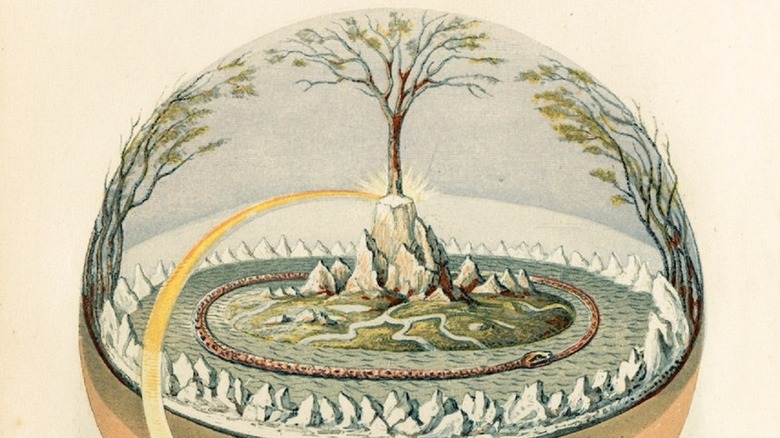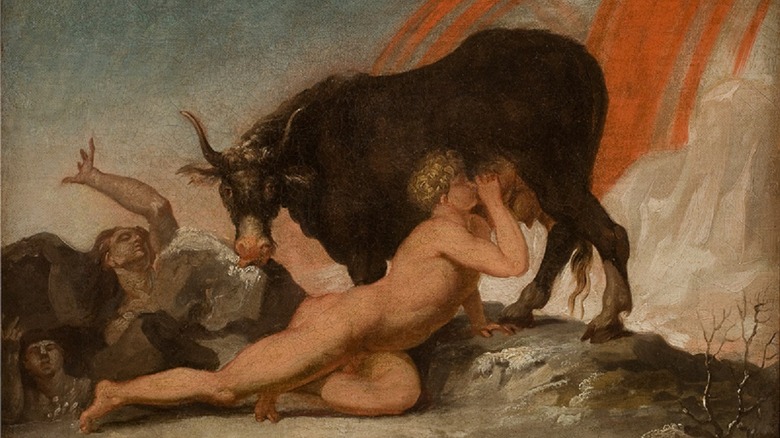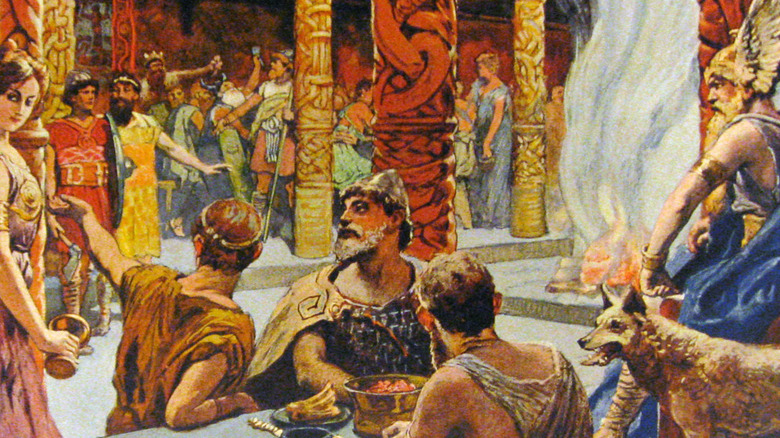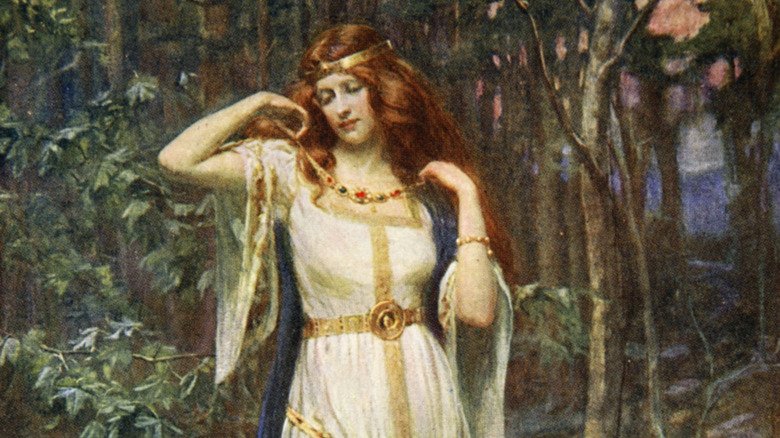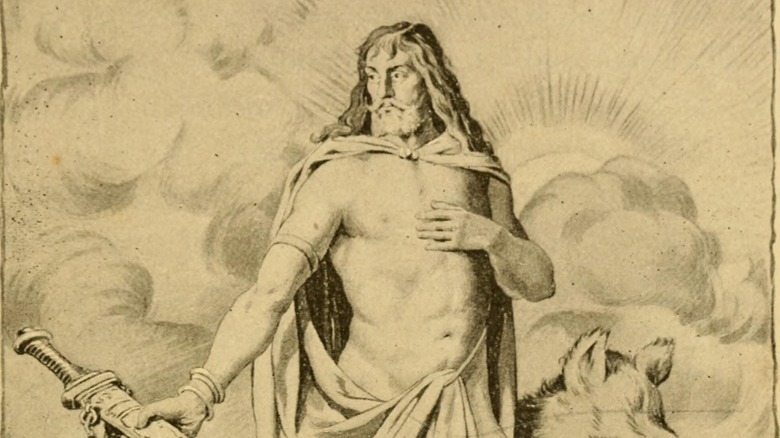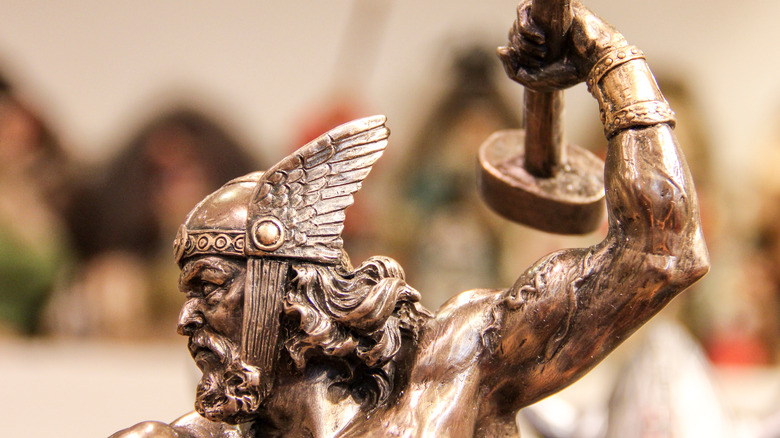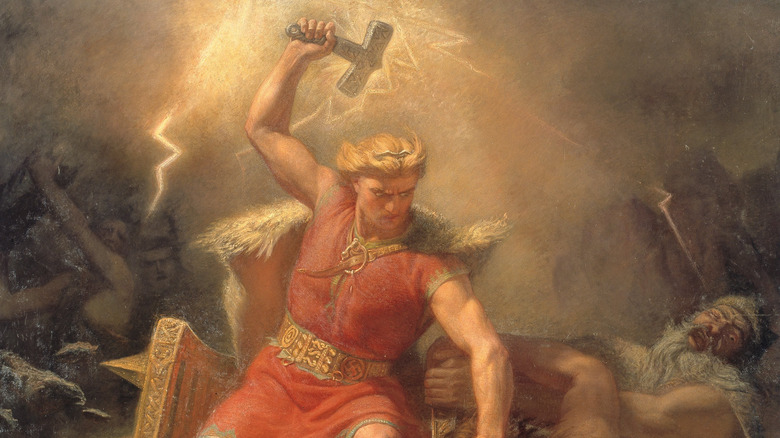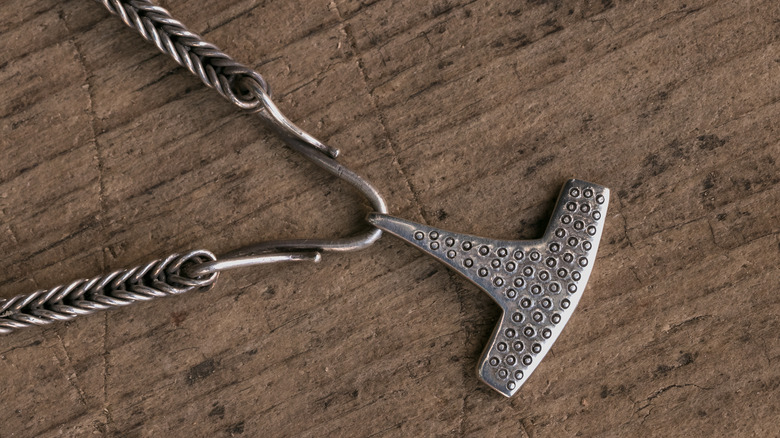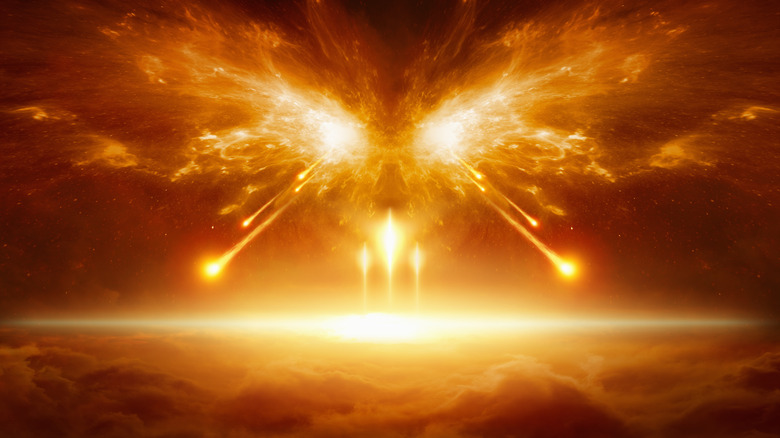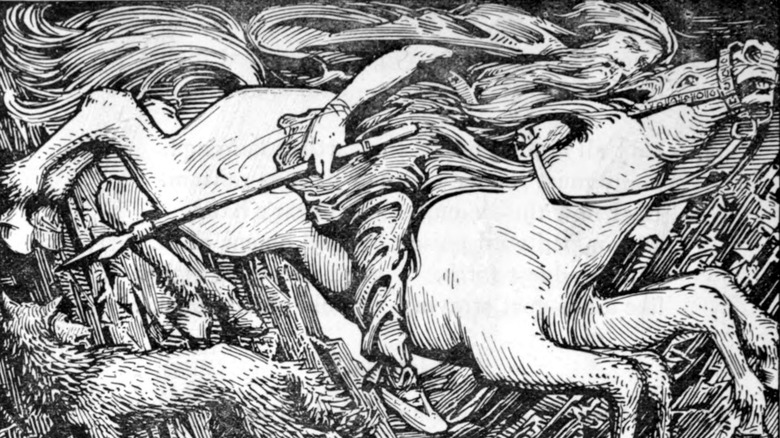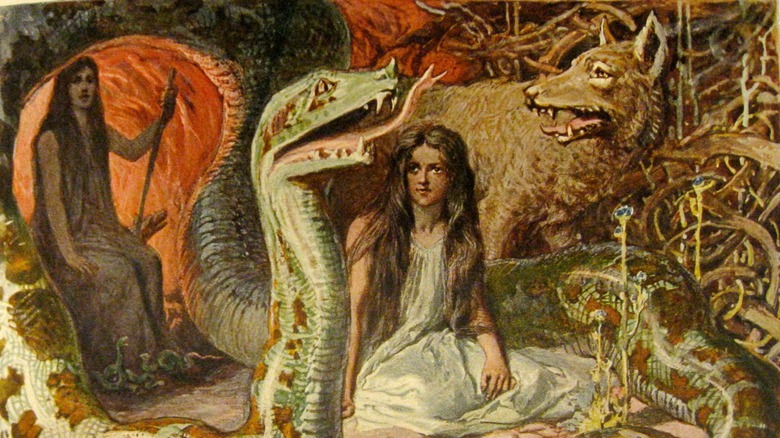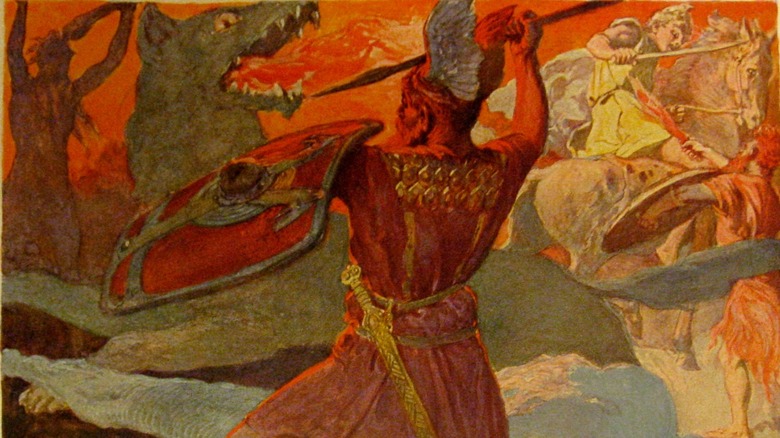The Nine Worlds Of Norse Mythology Explained
Of all the mythical traditions, there is something about the Norse that is evocative and deep. Why is this? One reason is the cosmology of the Norse and its imagery. It is multidimensional. It is a universe populated with creatures that have long influenced fantasy authors such as J.R.R. Tolkien. This imagery calls upon readers to explore places beyond the human experience. It also speaks to certain universal truths.
Another reason that Norse mythology is so powerful is that there is such limited source material. Aside from archaeological evidence, all sources for Norse mythology come from the two "Eddas." The World History Encyclopedia explains that these two works, one of poetry and the other prose, form all we really know about Norse mythology. Even these are somewhat flawed, particularly the "Younger Edda" (also known as "Prose Edda" and "Snorre's Edda"), which was a collection of prose stories compiled by Snorri Sturluson, an Icelandic poet in the 13th century. The "Younger Edda" was highly Christianized by Sturluson, who tried to reconcile the old Norse myths with Christianity. The "Elder Edda," which is entirely in verse, was rediscovered in the 17th century.
Taken together, these two works paint a highly compelling mythology that has been an inspiration for centuries. Perhaps most intriguing is the structure of the universe they create based on multiple worlds or realms. Let's take a look at the nine worlds of Norse mythology.
The Norse universe is based on a tree
The Norse universe was based a tree. As explained by the World History Encyclopedia, at the center of the world was a great ash tree called Yggdrasil. Interestingly, the name Yggdrasil means "Odin's Horse," according to "Tracing Old Norse Cosmology," which is described as "poetic metaphor... for 'gallows'." This refers to a myth in which Odin hanged himself on the tree.
Yggdrasil formed the framework and nourished the nine worlds, or realms, of Norse mythology. The tree was fed by three immortal wells. The first was Urd, where the Norns, who guided destiny, dwelled. The second was Mimir's Well. The third was Hvergelmir, where the dragon Nidhogg (sometimes Nithog) gnawed on the roots of Yggdrasil. In fact, Yggdrasil was positively alive with struggle. The Norse myths tell how serpents chewed on the tree's roots while mythical deer feed on its buds. Meanwhile, an eagle sits at the top of the tree and relay informations to Nidhogg through a divine squirrel.
As for the nine realms, "Norse Mythology A to Z" maintains that these were staggered into tiers that descended downward. However, the geography is never terribly clear. The upper worlds were the homes of the gods and the light elves, the middle levels included the realms of men, dwarfs, giants, and dark elves, while the roots of the great tree reached into realms of fire, ice, and the undead.
Time began with fire and ice
There are considerable variations to the Norse origin story, but one version as described by the World History Encyclopedia is that in the beginning there was a void called Ginnungagap, which had the fires of the realm of Muspelheim on one side and the colds of Niflheim on the other. When the fires of Muspelheim melted the ice of Niflheim, two primordial beings were created: Ymir the Frost Giant and Audhumla, a celestial cow.
The cow then licked salt ice to free Buri, the first of the gods. This led to a cascade of events ending with the slaying of Ymir by the god Odin and his brothers, Vili and Vé. According to "The Norse Creation Myth," the gods used the Ymir's body parts to create the world and its realms. The "Elder Edda" states, "They dragged the body of Ymir into the middle of Ginnungagap, and of it formed the earth. From Ymir's blood they made the seas and waters; from his flesh the land; from his bones the mountains; and his teeth and jaws, together with some bits of broken bones, served them to make the stones and pebbles." The gods also used Ymir's blood to make the oceans and his skull the sky.
Asgard was the realm of the high gods
The Aesir were one family of gods in the Norse pantheon, and they made their home in Asgard. The Aesir are the gods that most people are familiar with in Norse mythology and they include Odin, Thor, Loki, and Balder. Asgar is also one of the most well-described of the worlds, undoubtedly because it was of central concern to Norse religious beliefs.
"Norse Mythology A to Z" states that Asgard was protected by a huge wall and featured a green plain called Idavoll. About Idavoll were the different dwelling places of the gods. "Norse Myths" explains how this also included the famous halls of Odin called Valhalla, which means "hall of the chosen slain." This was where half of those who were slain in battle enjoyed an afterlife of eternal feasting. The other half went to Fólkvangr, a field managed by the goddess Freyja. As noted by Norse Mythology for Smart People, the primary sources do not describe Fólkvangr or what went on there.
According to the World History Encyclopedia, Asgard was connected to the human world physically. However, as the tale evolved, Asgard was moved into the heavens and became connected by Bifrost (also Bilrost), the rainbow bridge. This passage to the realm of the gods was, as stated in Britannica, guarded by Heimdall, who used a horn named the Gjallarhorn to summon the gods when needed.
Vanaheim was the home of the other gods
In Norse mythology, Asgard wasn't the only home of gods. A second family of gods, known as the Vanir, lived in Vanaheim. The World History Encyclopedia states that this second tribe of other gods were largely associated with magic and fertility. The Vanir and the Aesir had, according to tradition, gone to war for unknown reasons. "Creation Myths of the World" suggests that this war may have been due to the conflict between the ideals of order and war represented by the Aesir against the promotion of productivity by the Vanir. This reflects other ancient religious traditions of a conflict between pantheons such as the Olympians and the Titans in Greek mythology.
The two groups eventually made a truce, but not before the Vanir destroyed the walls of Asgard. In the aftermath, hostages were exchanged. The child gods Frey and Freyja as well as the sea god, Njord, were sent to Asgard while the gods Honir and Mimir were given to the Vanir. The Vanir, however, were unsatisfied with their hostages so cut the head off of Mimir and sent it back. Odin then used his sorcery to resurrect the head, which became a font of eternal wisdom.
Unfortunately, there is not much known about Vanaheim, although scholars assume that being in the upper realms of Yggdrasil with Asgard it was a pleasant, beautiful realm.
Alfheim was home of the bright elves
Norse mythology is populated with creatures that have since been used in fantasy novels and movies. The elves are one example. According to "Norse Mythology," there were actually two kinds of elves — the bright, or light, elves and the dark elves. The bright elves lived in Alfheim, and this place was on the same tier as Vanaheim and Asgard. Alfheim literally translates to "Elf world."
"Norse Mythology: Gods, Myths, and Religion" explains that not much is known about Alfheim except that at some point, Alfheim was also ruled by the Vanir god Freyr, who had been a hostage in Asgard. Scholars have yet to figure out the connection of Freyr to Alfheim, although since Freyr was a fertility god, it may imply that Alfheim was a bountiful realm. The World History Encyclopedia continues this track by noting that the light elves of Alfheim were, like elves in fantasy novels, magical, beautiful, and artistic. Since so little is known about Alfheim and its inhabitants, there is a mysterious allure about this Norse world.
Midgard was where humans lived
Midgard is translated by Britannica as "the middle abode" or "middle Earth," and this was the home to humanity. The name makes sense from a geographical point of view since Midgard was located between the icy realm of Niflheim in the north and the fiery world of Muspelheim to the south. The World History Encyclopedia points out that Midgard was connected to Asgard bys Bifrost, the rainbow bridge. Jotunheim, the land of giants was adjacent to Midgard. To protect humans from the giants, the gods erected a huge wall using Ymir's eyelashes.
Around the whole world was Jormungand, the so-called Midgard Serpent. Norse Mythology for Smart People explains that the serpent was in the ocean and was sometimes attributed as the cause of earthquakes among Germanic peoples.
Of the gods, the thunder god Thor has the closest relationship to Midgard. He was humanity's protector, and in his adventures, he slays giants and protects people from storms and seas. He was the most popular god in the Norse pantheon. His great enemy is the Midgard Serpent, who he is destined to kill.
Jotunheim was the land of giants
As mentioned, Jotunheim was where the giants lived — Jotun translates to "giant." "The Nine Worlds," places Jotunheim on the same celestial plane as Midgard. However, there has been some debate about the exact location, as noted by "Norse Mythology A to Z." Some say that Jotunheim refers to a specific place of mountains and freezing cold, while others view Jotunheim as the unknown lands that surround the edge of the world. Norse Mythology for Smart People explains that another name for Jotunheim was Utgard, which means "beyond the fence."
The conception of Jotunheim being a place of the unknown is supported by the World History Encyclopedia, which describes this realm as "a primordial place of chaos, magic, and untamed wilderness," one of high adventure and terrible danger. Thor made excursions into Jotunheim to slay giants, while the trickster god Loki originally came from this realm. In essence, Jotunheim was a land that symbolized the perils and adventures of the unknown.
Nidavellir was the realm of the dwarves
Below Midgard, within the earth, was Nidavellir. This, as explained by the World History Encyclopedia, was the realm of the dwarves. Norse mythology believed that dwarves emerged from Ymir's flesh, and that the gods gave them their sentience. The "Elder Edda" states, "At first they [ dwarves] were only maggots, but by the will of the gods they at length partook both of human shape and understanding, although they always dwell in rocks and caverns."
Nidavellir was a smoke-filled place due to the constant working of the dwarves at their forges. Here, they crafted some of the legendary weapons of Norse mythology, including Odin's spear and Thor's hammer, Mjolnir.
Nidavellir is also sometimes associated with Svartalfheim. Svartalfheim is the home to the dark elves, but some sources seem to indicate that Nidavellir was a part of Svartalfheim. This has led to some confusion as to whether Svartalheim and Nidavellir were originally separate realms in the Norse cosmography or whether they were the same. "Scandinavian Mythology" suggests that dark elves and dwarves may have been one and the same people, calling them "interchangeable" within the myths.
Muspelheim was the land of fire
The underworld of Norse cosmology had three realms, one of which was Muspelheim, a land of fire. "Norse Mythology" says that Muspelheim is only mentioned twice in the primary sources. In the first instance, the fires of this realm met with the colds of Niffelheim in the creation myth to create water and hence life. Thus, Muspelheim existed before time and it may be outside of Yggdrasil. It also could not be entered. The "Elder Edda" states, "It is a world too luminous and glowing to be entered by those who are not indigenous there."
Muspelheim is also the realm of the fiery giant Surter (also called Surtr). "The Encyclopedia of Imaginary and Mythical Places" explains that Surter is an agent of destruction and, according to the mythology, he is destined to destroy the world with fire in an apocalypse called Ragnarök. To do this, he has a sword of fire called Sviga Laevi, as well as a host of fire demons. They, it seems, will burn Yggdrasil, the world tree.
Muspelheim and Surter were featured in the 2017 Marvel film, "Thor: Ragnarok." At the beginning of the movie, Thor dukes it out with Surter and his minions. This is, strictly speaking, not in the Norse mythological canon, but it is fun to watch.
Niflheim was a primordial land of ice
Niflheim was a realm of cold and ice. Its name, as translated by "The Norse Myths," means "land of mists." Along with Muspelheim, this was one of the two primordial worlds that existed before time, and whose meeting gave birth to the universe. Due to it being a domain of ice, the Norse positioned it geographically far in the north and it was, at least originally, completely devoid of life, although one root of Yggdrasil reached into Niflheim.
The World History Encyclopedia explains that in some sources, a region of Niflheim may have been the abode of the goddess of the dead, Hel. As such, Niflheim, or at least regions of it, were inhabited by some of the dead. That is, if you didn't go to Valhalla for heroic acts, you were likely to end up in Niflheim. "Norse Mythology" asserts that this harsh, icy hellscape was where oathbreakers, murderers, and commoners ended up upon death. Still, there is some confusion about the difference between Hel's realm and Niflheim as "Norse Mythology A to Z" says that some scholars believe that Hel was just an older name for Niflheim.
Hel is different than Hell
The last of the nine worlds was Hel or Helheim. As described in "Norse Mythology," the name means "hidden" or "concealed." Hel's beginnings go back to Loki. After Loki had a daughter, also named Hel (or sometimes Hela), Odin sensed that she would be a source of great trouble. So he, according to the World History Encyclopedia, cast her into a region of Niffelheim that became her domain, where she ruled from a palace called Eljudnir.
Now while Hel is an abode of the dead, it was a bit different than Judeo-Christian concepts of hell. First of all, even if you were perfect and innocent, if you died of natural causes, you went to Hel. If you were murdered, you went to Hel. If you died of anything except gloriously dying in battle, you went to Hel. Hel was not so much a punishment as a place of separation.
However, that being said, the goddess Hel wasn't exactly a gracious host. There was only one way in and one way out. To go through, you had to cross a river of weapons. "Norse Mythology A to Z" describes how Hel gave feasts at a table called Hunger, how her knife was called Starvation, and how her bed was Sickness, and her curtains Misfortune. Hel was even more powerful than Odin, since she could hold souls even from him. Still, Norse Mythology for Smart People makes clear that the realm of Hel in the Norse sense was not a punishment or reward. It was merely a continuation of life in another place.
The worlds ends with Ragnarok, but not forever
In Norse myth, the universe is fated to end in one final battle called Ragnarök. According to "Norse Mythology," the effort to destroy the universe comes from Loki and his three children Hel, the Midgard Serpent, and the wolf Fenrir. In the battle that comes, Surter leads his fiery armies from Muspelheim and burns the world with his sword. Then, tragically, the gods meet their doom. Odin, Thor, and all the other gods are destroyed.
There are several variations about what happens after Ragnarök. Norse Mythology for Smart People explains that in one version of the story, the world disappears into the sea and all of creation is unmade forever. In a more upbeat version, Yggdrasil is badly damaged, but not destroyed. Two humans, Lif and Lifthrasir (which Britannica says are translated as "life" and "vitality"), will come out of hiding in the tree to renew the world once again.
